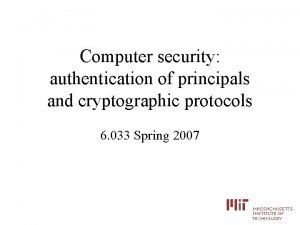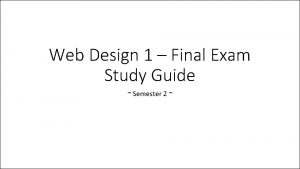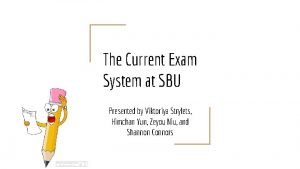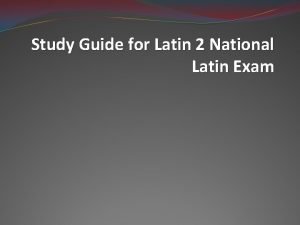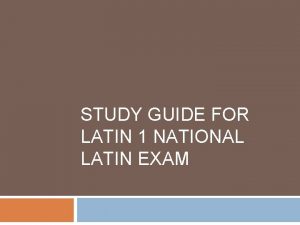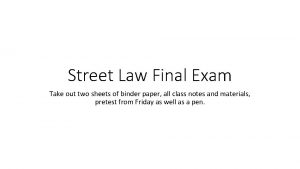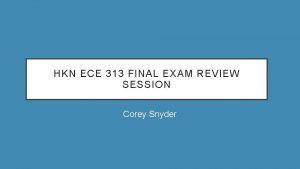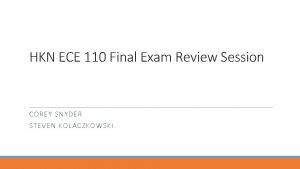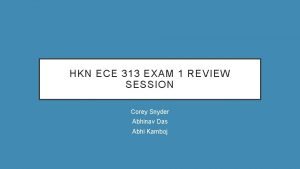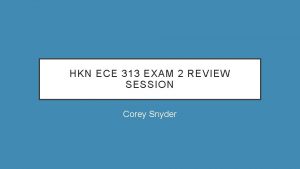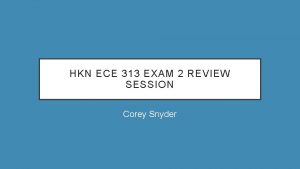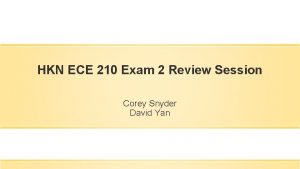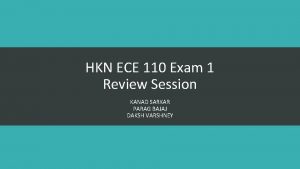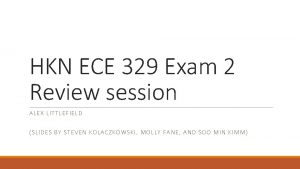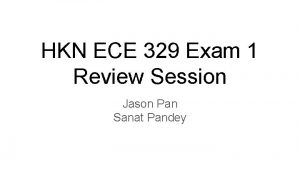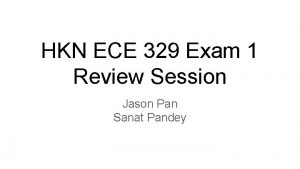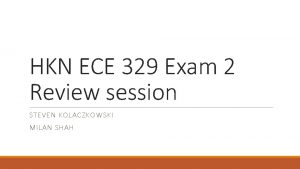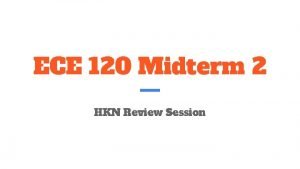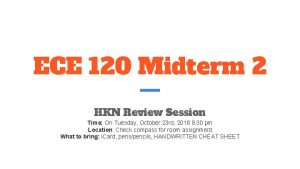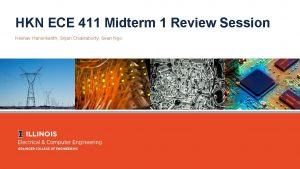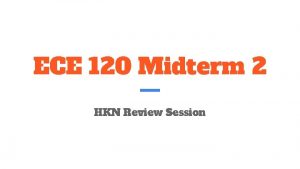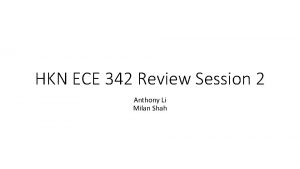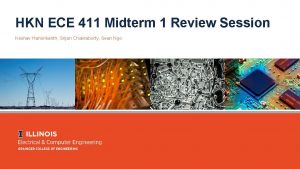HKN ECE 310 Final Exam Review Session Corey










































- Slides: 42

HKN ECE 310 Final Exam Review Session Corey Snyder Ben Eng

Topics • LSIC Systems and BIBO Stability • Sampling • Impulse Response and Convolution • Discrete Fourier Transform (DFT) • Z-Transform • Fast Fourier Transform (FFT) • DTFT and Frequency Response Circular Convolution • Digital Filter Design • Rate Conversion and Multirate Systems • D/A Conversion

LSIC Systems •

BIBO Stability •

Impulse Response •

Convolution •

Z-Transform •

BIBO Stability Revisited •

Discrete Time Fourier Transform •

Frequency Response •

Magnitude and Phase Response •

Ideal A/D Conversion •

Discrete Fourier Transform •

DFT Properties • Circular shift • Circular modulation • Circular convolution • We must amend our DTFT properties with the “circular” term because the DFT is defined over a finite length signal and assumes periodic extension of that finite signal.

Zero-Padding • We can improve the resolution of the DFT simply by adding zeros to the end of the signal • This doesn’t change the frequency content of the DTFT! • Instead, it increases the number of samples the DFT takes of the DTFT • This can be used to improve spectral resolution

Fast Fourier Transform •

Decimation in Time •

Fast Linear Convolution •

Linear Phase Filters • FIR vs. IIR – is there feedback? Types of FIR Filters: • Type 1 Odd Length and Even Symmetric • Type 2 Even Length and Even Symmetric • Type 3 Odd Length and Odd Symmetric • Type 4 Even Length and Odd Symmetric

Linear Phase Filter Design •

Digital Filter Structure • Direct Form II

Tips for Linear Phase Filter Design •

Upsampling •

Downsampling •

Ideal D/A •

Realizable D/A: Zero-Order Hold •

How does the ZOH Change our Spectrum?

Upsampled D/A •

P 1: CTFT to DTFT

P 2 : Non-unique Digital Frequencies •

P 3: DFT Matrices and the DFT •

P 4: DFT Shift Property •

P 5: Circular Convolution •

P 6 : La Mariposa (The Butterfly)

Butterfly Structure Exercise •

P 7: Zero Padding •

P 8: FIR and IIR Systems •

P 9: Filter Structure •

P 10 : GLP Filters •

P 11 : Window Method •

P 12 : Up, Down, and Around

P 13 : ADC /DSP /DAC/WTF
 Ece 329
Ece 329 Ece 310
Ece 310 Ece120 wiki
Ece120 wiki Ece 313 uiuc
Ece 313 uiuc Hkn review session
Hkn review session Hkn review session
Hkn review session Hkn review session
Hkn review session Writ of certiorari ap gov example
Writ of certiorari ap gov example World history spring final exam review answers
World history spring final exam review answers Spanish 1 final exam review packet answer key
Spanish 1 final exam review packet answer key Pltw human body systems final exam review
Pltw human body systems final exam review Poe practice test - materials answer key
Poe practice test - materials answer key Ied final exam review
Ied final exam review World history regular semester 1 review
World history regular semester 1 review Principles of business final exam answer key
Principles of business final exam answer key Spanish 2 final exam review answer key
Spanish 2 final exam review answer key Dinoflagellates
Dinoflagellates Ap world history final exam
Ap world history final exam Us history semester 2 review
Us history semester 2 review English 11 a semester exam
English 11 a semester exam Physics fall final exam review
Physics fall final exam review Physical science jeopardy
Physical science jeopardy Mat 1033 final exam answers
Mat 1033 final exam answers Fe exam statics review
Fe exam statics review Zoology final exam review
Zoology final exam review Earth science final exam
Earth science final exam Algebra 1 semester 2 final exam
Algebra 1 semester 2 final exam Hft 2401
Hft 2401 Personal finance final exam review
Personal finance final exam review Spanish 2 final review
Spanish 2 final review Psychology final exam review
Psychology final exam review Ece 313 uiuc
Ece 313 uiuc Among the four students of class v radha meera kamala
Among the four students of class v radha meera kamala![Hkn ]ds; Hkn ]ds;](data:image/svg+xml,%3Csvg%20xmlns=%22http://www.w3.org/2000/svg%22%20viewBox=%220%200%20200%20200%22%3E%3C/svg%3E) Hkn ]ds;
Hkn ]ds; Hkn underground guide
Hkn underground guide World history and geography final exam study guide
World history and geography final exam study guide Web design final exam
Web design final exam Us history semester 1 final exam
Us history semester 1 final exam Sbu finals schedule
Sbu finals schedule National latin exam results
National latin exam results National latin exam practice
National latin exam practice Street law final exam
Street law final exam Difference between lytic and lysogenic cycle
Difference between lytic and lysogenic cycle
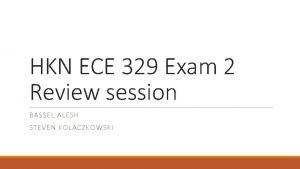
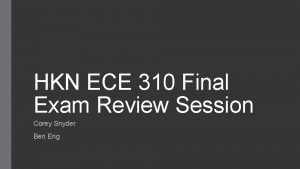
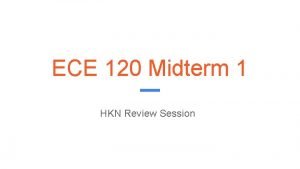
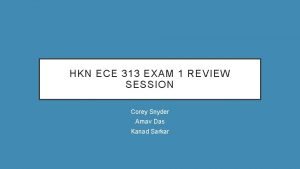

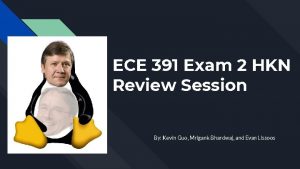
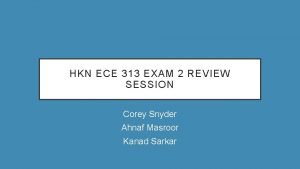















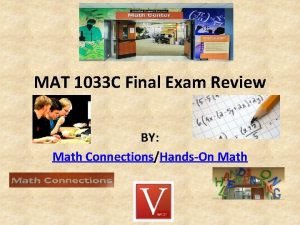
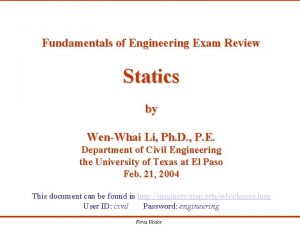



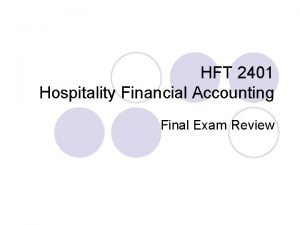


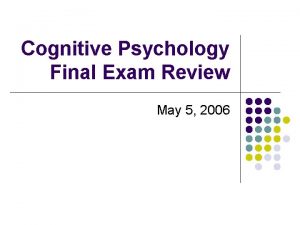
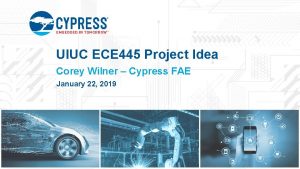

![Hkn ]ds; Hkn ]ds;](https://slidetodoc.com/wp-content/uploads/2020/12/3486362_ccd0d532001754d4165101283a392602-300x208.jpg)
